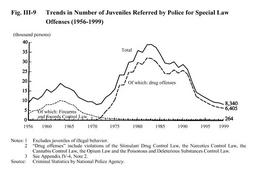| Previous Next Index Image Index Year Selection | |
|
|
1 Number of juveniles referred by the police Fig. III-9 shows the number of juveniles referred by the police for special law offenses excluding road traffic violations and other traffic-related law violations since 1956, the year when Criminal Statistics by National Police Agency started to identify details of juvenile special law offenses (see Appendix III-6 ).
Fig. III-9 Trends in Number of Juveniles Referred by Police for Special Law Offenses (1956-1999) The total number of juveniles referred for special law offenses has peaked twice thus far:in 1963 at 18,967 and in 1983 at 39,062. By offense, Firearms and Swords Control Law violations had the largest share in the number of juveniles referred for special law offenses, other than traffic-related law violations from the late 1950s through the early 1960s, accounting for more than 50% of the total during several years around 1963. Such violations have, however, decreased rapidly ever since. Their place was taken by drug-related offenses, which have increased significantly since the early 1970s. Poisonous and Deleterious Substances Control Law violations account for an overwhelming majority of juvenile drug-related offenses, followed by Stimulant Drugs Control Law violations.By offense, Poisonous and Deleterious Substances Control Law violations had the largest share (63.3%)in the total number of juveniles referred in 1999 for special law offenses other than traffic-related law violations, followed by Stimulant Drug Control Law violations (11.9%) and Minor Offense Law violations (6.5%). Poisonous and Deleterious Substances Control Law and Stimulant Drug Control Law violations increased 2.7 points and 0.5 points, respectively, from the previous year. |
